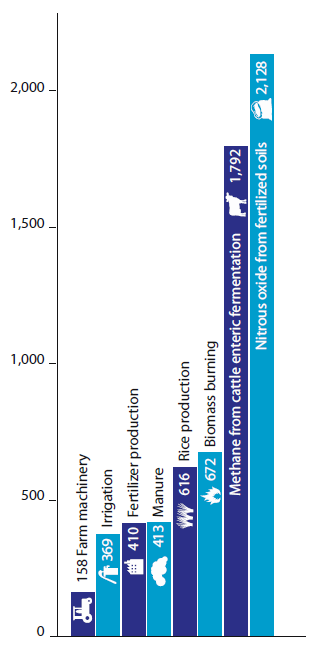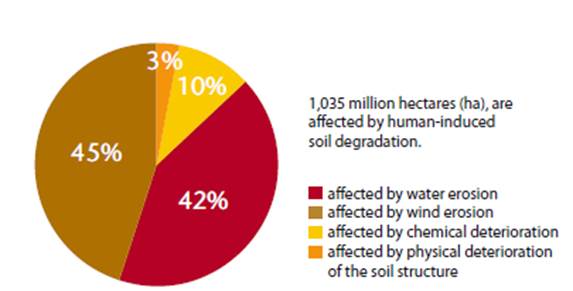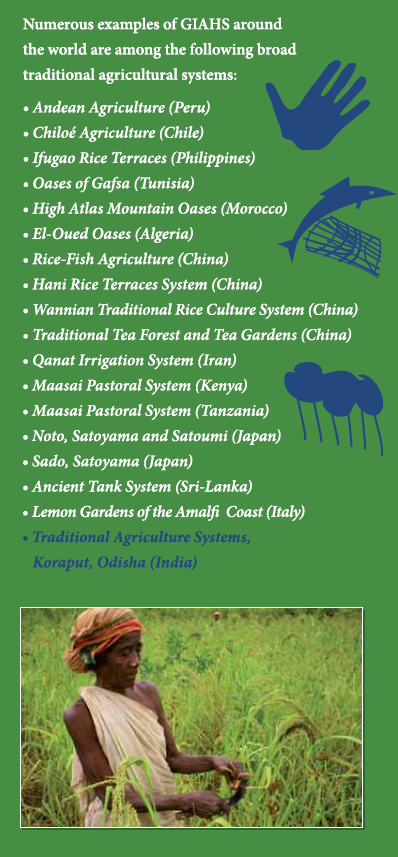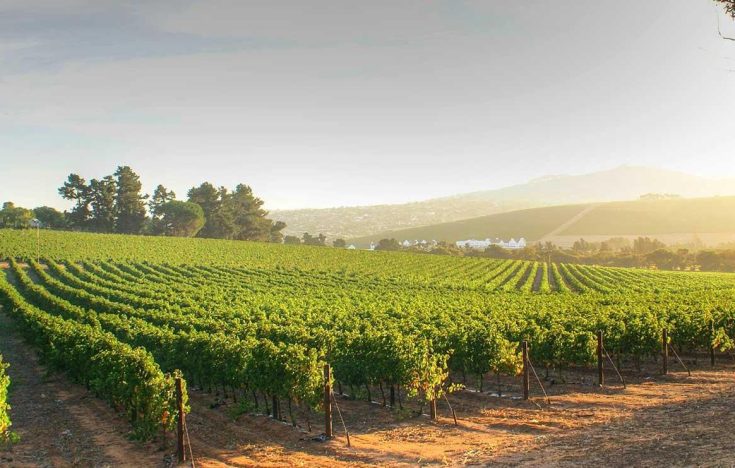Few topics are as intrinsically and emotionally related to the “human condition” as agriculture. Farming was the key enabler driving humankind to adopt a new social mode of life. Until as recently as the 19th century, a majority of the European population worked in farms. Whether for mass consumption or for fine dining, agriculture processes and traditions are responsible for what people eat around the world.
And this link is often at the heart of identities and traditions, of how people define themselves, from the cassoulet in France cuisine and pasta in Italy, to sushi in Japan and dumplings in China. The necessity of eating has often also become a source of both pleasure and of identity.
This fundamental link to identity and to humanity itself has made agriculture an emotional topic, in addition to keeping farmers as core political constituents in most countries. It has also for long acted as the incentive for initiatives to fight for quality of food. The organic and the “Natural” movements did not start with the Paris Agreement on climate change; initiatives against food with low nutritive value and promoting a more authentic and more traditional way of farming have been shaping up for decades. As global food companies like Danone are switching their entire business model toward healthy and natural products and fully embracing sustainability and social responsibility as part of their corporate culture, such trends are now mainstreams and on the verge of global recognition.
When the Paris Agreement highlighted the role of agriculture in climate change, it was no discovery: the growing public awareness of problems surrounding the production of food, fibre, and other farming-driven plant and animal products meant there was already extensive support for sustainable agriculture. This had already created a robust market for sustainable foods leading to increasing demand for transparent agricultural regulations. The use of sustainable farming techniques has therefore enjoyed rapid growth.
Sustainable agriculture is not only about soil health, reduced water and energy use, and lower pollution levels on farms; it is also about public health, local communities, animal welfare – the entire food production and supply chain. Sustainable farmers are increasingly concerned with identifying emissions/water/energy “hotspots” in the supply chain as well as assessing the trade-offs of interventions at its different stages, but also farmworkers’ wellbeing, strengthening the local economy, and evaluating the impacts of new practices and technologies on the environment and on the end product.
Traditional agricultural practices are often labelled sustainable. The continued use and deployment of those practices may therefore not only preserve human diversity and heritage, it is poised to also protect the planet. While taking advantage of all technological advances and applying sustainable strategies, preserving the heritage of humanity may become a game-changer for the future of the planet, and for instilling a sustainable mind-set in the population.
A system perspective on agriculture
Agriculture is the cultivation of land for the advantage of selected species including agricultural crops, livestock, tree crops and grazing lands
Source: IUCN / Agricultural Ecosystems: Facts and Trends, p.4
Agriculture is central to society and, as a result, solving the challenges arising from the sector and embracing sustainable strategies are important. Agriculture may help foster healthy population, provide income to rural communities, help manage natural resources well, support biodiversity, etc. Therefore, significant investments in the sector’s infrastructure are both necessary and welcome. Governments, banks and corporations must coordinate to support local businesses, improve rural livelihoods, reduce hunger and poverty, facilitate environmentally, socially, and economically sustainable development, among others.
The economics of agriculture cannot be narrowly focused on short-term views. A core component of the preservation of the environment, agriculture impacts everything, from quality of drinking water to availability of land for construction, from which food is available to the levels of required infrastructure to sustain populations and industries in some regions.
This holistic view is reinforced when climate change is taken into consideration, with elements such as the use of carbon-based chemicals for farming, the contribution of the meat industry to CO2 emissions, the use of plastic in the go-to-market approach or the overall CO2-cost of transport. In this context, a systemic view that takes into consideration a complex ecosystem is necessary and requires a long-term view with strategic commitments.
Environmental health

Agriculture is therefore a major source of GHG emissions: in addition to releasing large quantities of carbon dioxide (through the burning of biomass), it also releases up to half of all methane emissions. The breakdown of total global methane emissions and global carbon dioxide emissions by sector indeed vividly demonstrate the significant agriculture’s input in global manmade GHG emissions.
Agriculture is among the main sources of air pollution and becoming more important as pollution from industry and transport are generally subject to tighter controls. Without further action agriculture’s contribution to air pollution may further increase.
Source : European Commission, 2015
![Global GHG emissions by gas and by economic sector [Source: IPCC, 2014]](https://cib.bnpparibas/app/uploads/sites/2/2021/03/20181017174954-global-ghg-emissions-by-gas-and-by-economic-sector.jpeg)
Despite staying for a shorter time in the atmosphere, methane is, as stressed by the Food and Agriculture Organisation of the United Nations (FAO), “about 20 times more powerful than carbon dioxide in its warming action and is therefore a major short-term contributor to global warming.” (Source: FAO)
In addition to this, agriculture accounts for a major share of human use of water: according to OECD, agriculture accounts for 70% of human water use (not to forget its contribution to water pollution from excess nutrients, pesticides and other pollutants). It also accounts for a major share of the land: in 2015 pasture and crops alone took up 37 % of the earth’s land area (FAO).

Pollution does not only refer to the contamination of the atmosphere by harmful chemicals or biological materials; it can also severely impact food security and make soil less fertile. The health of the soils is therefore subject to pollution, but also to the quality of agricultural practices themselves, among other factors. In other words, agriculture, if not sustainable, eventually leads to low nutrient status of soils and poor water-holding capacity, soil compaction, susceptibility to erosion, and ultimately various plants diseases, nematode, or insect damage.

Social Equity: How local communities, sustainable farming and economy are linked
The hunt for farming yield has over several decades often been correlated with a negative effect for the soil and for the environment. Increasingly, however, movements to help small farmers, arising both from global sources and from local initiatives, have pushed for a rebalancing of forces between large-scale farmers and small/family farms.The significant negative impacts caused by the large-scale producers reinforce the family farmer’s positive role in making the global food system, and ultimately the world, more sustainable. A growing number of initiatives supporting the small-scale farmers (such as Fundatia ADEPT in Romania or North Leupp Family Farm (NLFF) in the US), have sought to ensure food and nutrition security, protect the environment, improve livelihoods, protect biodiversity, and create new markets for local production.
Despite that family farms already manage most of the world’s farmland – the number reached 70% in 2014, according to FAO – it is yet not enough to ensure the local communities’ food-security. Investment into large-scale farming today often results in a loss of income among local people, especially in the areas with relatively high population densities.
Several established schemes supporting agriculture are still helping farmers based on the scale of production, such as the European Union’s Common Agricultural Policy (“CAP”), which has long tended to favour large producers over smaller family-size farms. However, even such eminently political policies are changing over time and the most recent iteration of the CAP is taking into consideration the environmental aspect of farming: the preservation of the environment and rural development are key pillars of the policy, with an even stronger focus poised to be developed and discussed at the EU level for the next round of agricultural policy after 2020.
However, in the West, a market-based emphasis is increasingly put on local and healthy farming, starting to change the habits, with, for example, many large scale supermarkets emphasising locally-sourced food products over mass-scale productions requiring heavy transportation, and pushing bio and healthy products ever more as the demand evolves from end customers. These early successes should not make us forget the fact that, while such initiatives exist and help move the needle in the right direction, further efforts need to be pushed and generalised to achieve sustainable results.
In that respect the twin role of investors’ appetite for projects of this kind and of the banking ecosystem being a proponent to channel investments towards the most promising and impactful projects will be key to make sure the necessary transformation of the global agricultural landscape is supported adequately.
Globally Important Agricultural Heritage Systems (GIAHS): Bringing traditions back to farming
As the need for more sustainable, resilient, and socially just models of agriculture is being recognised, the existing ingenuity of agricultural heritage systems – those shaped and maintained by generations of farmers – have been revisited. These agricultural models are built on local knowledge, based on its profound relationship with nature and, as a result, conditioned by landscapes and natural resources. Moreover, these agriculture practices are vivid testimonies of the evolution of civilisation. Today the diverse world’s agricultural systems embrace the diversity of knowledge globally, while using locally adapted management practices.
As of today, 52 recognised Agricultural Heritage Systems can be found all over the world, from the “Rice Fish Culture” of China and the “Saffron Heritage of Kashmir”, to the “Andean Agriculture” of Peru and the “Chinampas Ancient Agricultural System of Floating Gardens” of Mexico.
Practically speaking, GIAHS are outstanding landscapes of aesthetic beauty that combine agricultural biodiversity, resilient ecosystems and a valuable cultural heritage.” (Source: FAO) In this regard, the GIAHS’s register is the list of “World Heritage of Humanity” for Agriculture. Just like the “World Heritage” institutionalised by UNESCO promotes diversity and awareness, increases recognition, and distributes the knowledge about world’s cultures, GIAHS Initiative promotes public understanding, awareness, national and international recognition of Agricultural Heritage systems. But also like the world heritage these systems are under threat from human activity as well as from climate change.

Such GIAHS – and the effort by the global community to protect and preserve them – are testimonies to how traditional farming methods can be upgraded by current technologies to improve methods and yields on a sustainable basis, without adopting mass-farming carbon-heavy methods.
While these methods cannot (yet?) account for the entire food and farm production required on a global level, the multiplication of these initiatives to foster locally-grown productions using sustainable and locally-adapted ways, will foster a general adaptation of the industry that, ultimately, will improve the agriculture complex “system” and, over-time, improve its ecological yield.
Wines: A Case in (Parker’s) points
No segment of the agriculture sector is more impacted by these trends (local productions, focus on healthy farming, natural and traditional methods) than the wine industry. Without going back to the history of wine, present for millenaries in culture (no Hellenist can forget the sights of Dyonisos’ feast representations in Greek sculpture!), wine has been part of the history of the world both culturally and from a farming standpoint.With a focus on flavour above everything, and centuries of traditions in regions such as France, Italy or Spain, wines have attained a cult status in addition to a mass production status. Bottles can be sold for a few dollars or for hundreds of thousands of dollars depending on their origin, the producer, the year of production, etc.
![The Japanese Traditional Washoku has been inscribed on the UNESCO Intangible World Heritage List alongside the Mediterranean diet, and the Gastronomic meal of the French. [Source: UNESCO]](https://cib.bnpparibas/app/uploads/sites/2/2021/03/20181023095057-the-japanese-traditional-washoku.jpeg)
This last point is the most important one for the purpose of our analysis. As the market for wine grew, consumers became also more knowledgeable and required more information. While it is difficult for the majority of the population to recognise by taste two kernels of corn or two tomatoes without specific knowledge, wine amateurs started to recognise and pay premium for quality based on local productions and idiosyncrasies of the producer, the soil and the age.
This has translated over the years to specific branding for specific regions like Burgundy, Bordeaux, Tuscany or Napa. It has also fostered an entire restructuring of the industry around authenticity, around locally adaptable idiosyncrasies. While it may not possible for all wine regions to go as far as being recognised by UNESCO for its multitude of microclimates like the ‘Climats de Bourgogne”, on a global scale a new generation of wine producer is taking over and intends to promote the specificities of their own wines, made of grape, soil, weather and winemaking techniques and human decisions.*
Increasingly, winemakers are adopting the “organic” and “biodynamic” labels, and are turning toward a more traditional wine growing and winemaking techniques to rediscover the uniqueness of their own “terroirs” and to focus on quality rather than on quantity. Such methodologies insist on the use of compost as fertiliser rather than chemical compounds, avoiding most pesticides, etc. Such trends can be identified both in traditional wine regions (Italy, France, Spain, Germany, Hungary) but also in the New World (USA, Australia, South Africa, Chile, Argentina), with over 10% of the production in France being Organic and constantly growing (as of 2014, source: An Overview of the Biodynamic Wine Sector, Sept 2016, by A. Castellini, C. Mauracher and S. Troiano).
The elegance of a wine, its unique and vibrant aromas, its bouquet, are some of the characteristics that bring out the true richness of the terroir – the soil – sought by the winemaker. It is this that gives rise to a nectar that expresses the distinctiveness of the land, whatever the climate. It is truly of a “cultural singlemindedness” with its simple, but determined, goal of giving back to the enthusiast. And yet the terroir is never something that is fixed: it evolves with the passing of time, with its ongoing interactions and, especially, in the imagination and in the human endeavour to always improve and surpass.
By Jean-Claude Ribaut
The process is ongoing and such trends are in part based on sustained demand for more healthy, natural and region-specific products. However, the marketing imperative to differentiate products on a mass market now that products of good quality can come from any place in the world, is bringing a return to the basics of locally-adapted agriculture techniques, including growing indigenous grapes, adapting methods to local weather and local soil, and using winemaking techniques that highlight the grapes used and the local weather instead of endeavouring to produce an undifferentiated product with a standard undifferentiated taste like the proponents of oak-based tastes did in the 1980s and the 1990s.
Overall, the local producers focusing on quality driven from locally-adapted productions see their production increase every year, which is illustrated by the constantly increasing price of quality wine even in non-traditional “old world” regions. Consumers have been, over time, educated to recognise the value of quality and differentiated product.
And increasingly, the difference comes from becoming sustainable and locally-adapted.
A long-lasting ambition
Agriculture is the most significant sector of our collective imagination. Rooted in centuries of experience and reflecting local cultures around the world, it is a strategic sector in the middle of a structural transformation towards more traditional and sustainable methods of farming, aiming at both maintaining production yields while ditching chemicals and limiting GHG emissions as much as possible. Such transformation is a long-lasting ambition that renders agriculture both more sustainable and more socially efficient for local communities globally. It is also a transformation that cannot occur overnight and requires a systemic change in the food chain, from production to transportation. Examples in sub-segment of the industry, like the wine industry, can hint at how this evolution could take shape over a generation, with a drive arising from consumer demand ultimately changing the production methods and the logistics value chain.
Ultimately, the changes are ongoing and will take shape over time, helping the industry reduce its environmental footprint through improved techniques, better technology, evolving consumer demand – and a flow of capital accelerating the transformation to fit the demands of end-consumers.
